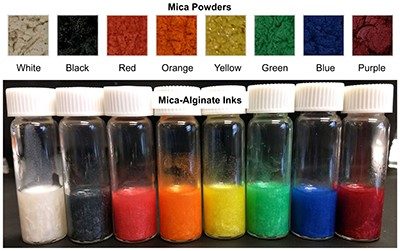FOR IMMEDIATE RELEASE
ACS News Service Weekly PressPac: August 04, 2021
ArtSea Ink: a colorful, seaweed-based ink for 3D printing
Some artists are embracing 3D printing as a new medium, allowing them to create intricate 3D compositions that are difficult to produce in any other way. But the rigid, plastic-based materials used in many 3D printers require high heat for workability. Now, researchers reporting in ACS Omega have developed a colorful new ink for 2D and 3D art made of mica pigments in alginate, a sugar from seaweed that forms a stable gel without heat.
Although most 3D printers use petroleum-derived raw materials, alginate has also been explored as an inexpensive bioink. In water, the material forms a viscous gum that transforms into a robust hydrogel when cross-linked with calcium ions. But whereas plastics are available in many colors, alginate is almost colorless. Because color is such a vital component of art, Anne Arnold and colleagues wanted to add mica powders to alginate to create a new, vibrant ink for 2D and 3D compositions.
The researchers prepared an 8% alginate solution in water and added one of eight different colors of mica pigments. The mica powders dispersed completely in alginate solutions –– creating vibrant, pearlescent colors. The researchers could control the consistency of the media by adding more or less of the calcium chloride crosslinker. The team demonstrated the new bioinks, which they call ArtSea Ink, by 3D printing 2D art of a firefly, with a glow-in-the-dark additive to depict its abdomen, and a 3D structure showing the anatomy of the human brain. The 3D structures were stable over a period of several weeks if kept in a neutral, 200 mM calcium chloride solution. Although the alginate art currently isn’t stable over the long term, this could actually be an advantage because the material, unlike plastic, will biodegrade quickly if discarded, the researchers say.
The authors acknowledge funding from the Pacific Northwest National Laboratory.
###
The American Chemical Society (ACS) is a nonprofit organization chartered by the U.S. Congress. ACS’ mission is to advance the broader chemistry enterprise and its practitioners for the benefit of Earth and all its people. The Society is a global leader in promoting excellence in science education and providing access to chemistry-related information and research through its multiple research solutions, peer-reviewed journals, scientific conferences, eBooks and weekly news periodical Chemical & Engineering News. ACS journals are among the most cited, most trusted and most read within the scientific literature; however, ACS itself does not conduct chemical research. As a leader in scientific information solutions, its CAS division partners with global innovators to accelerate breakthroughs by curating, connecting and analyzing the world’s scientific knowledge. ACS’ main offices are in Washington, D.C., and Columbus, Ohio.
To automatically receive press releases from the American Chemical Society, contact newsroom@acs.org.
Note: ACS does not conduct research, but publishes and publicizes peer-reviewed scientific studies.
Media Contact
ACS Newsroom
newsroom@acs.org
View the image


